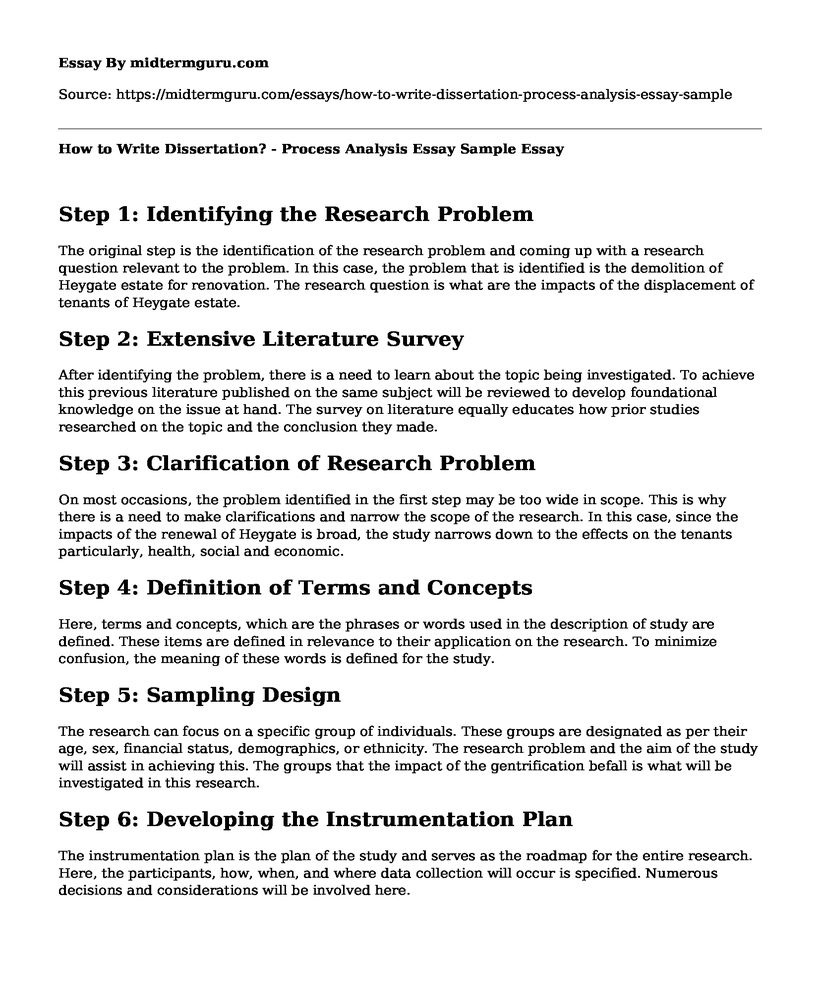Step 1: Identifying the Research Problem
The original step is the identification of the research problem and coming up with a research question relevant to the problem. In this case, the problem that is identified is the demolition of Heygate estate for renovation. The research question is what are the impacts of the displacement of tenants of Heygate estate.
Step 2: Extensive Literature Survey
After identifying the problem, there is a need to learn about the topic being investigated. To achieve this previous literature published on the same subject will be reviewed to develop foundational knowledge on the issue at hand. The survey on literature equally educates how prior studies researched on the topic and the conclusion they made.
Step 3: Clarification of Research Problem
On most occasions, the problem identified in the first step may be too wide in scope. This is why there is a need to make clarifications and narrow the scope of the research. In this case, since the impacts of the renewal of Heygate is broad, the study narrows down to the effects on the tenants particularly, health, social and economic.
Step 4: Definition of Terms and Concepts
Here, terms and concepts, which are the phrases or words used in the description of study are defined. These items are defined in relevance to their application on the research. To minimize confusion, the meaning of these words is defined for the study.
Step 5: Sampling Design
The research can focus on a specific group of individuals. These groups are designated as per their age, sex, financial status, demographics, or ethnicity. The research problem and the aim of the study will assist in achieving this. The groups that the impact of the gentrification befall is what will be investigated in this research.
Step 6: Developing the Instrumentation Plan
The instrumentation plan is the plan of the study and serves as the roadmap for the entire research. Here, the participants, how, when, and where data collection will occur is specified. Numerous decisions and considerations will be involved here.
Step 7: Collect of Primary and Secondary Data
After planning how the study will be developed, a collection of data which is a critical step will follow. What is important here is the provision of information required to answer the research question. Data will be gathered from both literature or subjects relevant to the research problem. Data, in this case, will be collected from semi-structured interview questions.
Step 8: Analysis of the Collected Data
In this step, all the efforts from the efforts step culminate here. The data collected is analyzed to answer the research question in line with the instrumentation plan. The results of the analysis will then be reviewed then summarized.
Step 8: Generalization and Interpretation
Here, the results of the analyzed data will be interpreted and discuss the research question. It is here that the conclusion of the research will be developed.
Step 9: Preparation of the Dissertation Report
This step involves putting everything about the research in the paper for publication.
Cite this page
How to Write Dissertation? - Process Analysis Essay Sample. (2022, Oct 23). Retrieved from https://midtermguru.com/essays/how-to-write-dissertation-process-analysis-essay-sample
If you are the original author of this essay and no longer wish to have it published on the midtermguru.com website, please click below to request its removal:
- Special Teaching in Higher Education - Paper Example
- Personal Statement Essay: Why College?
- Research Paper on College Student-Athletes and Academic Success
- Does Language Shape the Mind? - Paper Example
- Paper Example on Solutions to Old-Age Parenting
- A Lunch Conversation With My Grandmother - Essay Sample
- Depression in College Students: Annotated Bibliography







